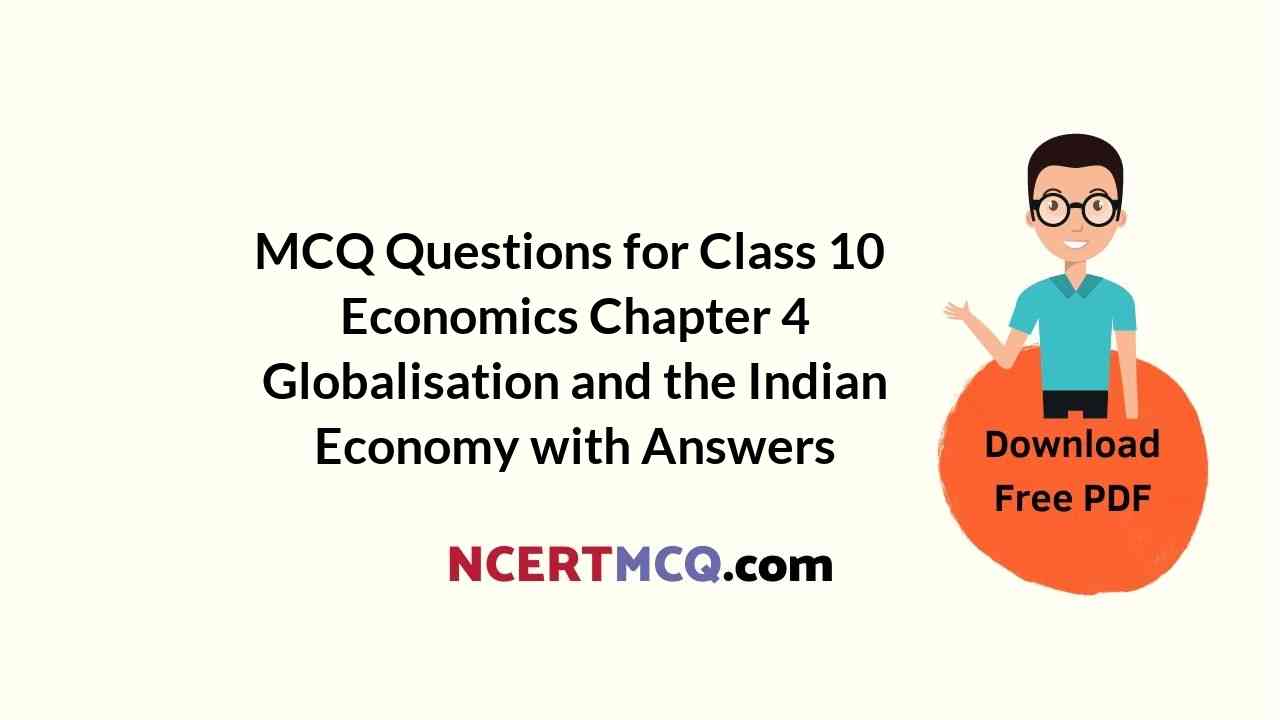Students can also read Online Education MCQ Questions for Class 10 Economics Chapter 4 Globalisation and the Indian Economy Questions with Answers hope will definitely help for your board exams. https://ncertmcq.com/tag/globalisation-and-the-indian-economy-class-10-mcqs-questions/
Class 10 Social Science Economics Chapter 4 MCQ With Answers
Economics Class 10 Chapter 4 MCQs On Globalisation and the Indian Economy
Class 10 Economics Chapter 4 MCQ With Answers Question 1.
Which one of the following organisations lag stress on liberalisation of foreign trade and foreign investment?
(a) International Monetary Fund
(b) International Labour Organisation
(c) World Health Organisation
(d) World Trade Organisation
Answer:
(d) World Trade Organisation
Explanation: The World Trade Organisation was created with an aim to regulate and monitor if appropriate rules were being implemented by the countries.
Globalisation And The Indian Economy Class 10 MCQ Question 2.
Choose the correctly matched pair:
(a) Sundaram Fasteners – Indian MNC
(b) Ranbaxy-Chinese MNC
(c) Ford Motors-British MNC
(d) Xiaomi-Korean MNC
Answer:
(a) Sundaram Fasteners-Indian MNC
Explanation: Ranbaxy-Indian MNC
Ford Motors-American MNC
Xiaomi-Chinese MNC
Globalisation Class 10 MCQ Question 3.
Entry of MNCs in a domestic market may prove harmful for
(a) Large scale producers
(b) Domestic producers
(c) Native Bankers
(d) Exporters of goods
Answer:
(b) Domestic producers
Explanation: The entry of MNC into the domestic market will prove fruitful to native bankers, large scale producers as they will be involved in the manufacturing and exporters as export will improve. The domestic producers alone will be harmed as it might close down their production.
![]()
Globalisation MCQ Class 10 Question 4.
Which one of the following has been major source of foreign investment in the IT industry?
(a) Bharat Heavy Electricals Limited
(b) Oil India Limited
(c) Steel Authority of India Limited
(d) Business process outsourcing
Answer:
(d) Business process outsourcing
Explanation: The other choices are all manufacturing units.
Which among Mex, RCH2X, R2CHX , and R3CX is most reactive towards sn2 reaction.
Globalisation And The Indian Economy MCQ Question 5.
Which one of the following types of countries has been more benefited from Globalisation?
(a) Rich countries
(b) Poor countries
(c) Developing countries
(d) Developed countries
Answer:
(c) Developing countries
Explanation: Employment has been generated to the youth in many developing countries, which means better quality of living.
MCQ On Globalisation Class 10 Question 6.
Which one of the following Indian industries has been hit hard by globalisation?
(a) IT
(b) Toy making
(c) Jute
(d) Cement
Answer:
(b) Toy making
MCQ Of Globalisation Class 10 Question 7.
Removing barriers on or restrictions set by the government is known as:
(a) Globalisation
(b) Privatisation
(c) Nationalisation
(d) Liberalisation
Answer:
(d) Liberalisation
Globalization Class 10 MCQ Question 8.
Ford Motors set up its first plant in India at
(a) Kolkata
(b) Mumbai
(c) Chennai
(d) Delhi
![]()
Class 10 Globalisation MCQ Question 9.
…………. has helped most in the spread of production of services.
(a) Manufacturing Industry
(b) Automobile Sector
(c) Call centres
(d) IT Sector
Answer:
(d) IT Sector
Globalisation Refers To MCQ Question 10.
“MNCs keep in mind certain factors before setting up production”. What of the following statements is wrong when that assertion is concerned?
(a) MNCs keep the availability of cheap skilled and unskilled labour in mind.
(b) Proximity to markets is another important factor when MNCs are established.
(c) Presence of a large number of local competitors also changes the opinions of people while establishing an MNC.
(d) Favourable government policies are important for establishment of an MNC.
Answer:
(c) Presence of a large number of local competitors also changes the opinions of people while establishing an MNC. Explanation: MNCs are not interested in the local competitors as most of their products are for the export market.
Globalization Refers To MCQ Question 11.
…………… have led to a huge reduction in port handling costs and increased the speed with which exports can reach markets.
(a) Containers
(b) Airports
(c) Vessels with Stands
(d) Ships
Answer:
(a) Containers
Globalization MCQs Class 10 Question 12.
Cheaper imports, inadequate investment in domestic infrastructure might lead to
(a) the slowdown in the agricultural sector
(b) the slowdown in demands of domestic goods in the country
(c) the slowdown in the industrial sector
(d) slowdown in services
Answer:
(b) the slowdown in demands of domestic goods in the country
MCQ Of Globalisation And Indian Economy Question 13.
Which of the following country is NOT in the list of countries whom Ford Motors exporting its cars?
(a) South Africa
(b) Mexico
(c) Brazil
(d) All of these
Answer:
(d) All of these
Explanation: Ford Motors, an American company, is one of the world’s largest automobile manufacturers with production spread over 26 countries of the world.
Related Theory
Ford Motors came to India in 1995, invested Rs.1700 crore to set up a plant near Chennai in collaboration with Mahindra and Mahindra, manufacturer of jeeps and trucks in India.
![]()
MCQ Globalisation Class 10 Question 14.
Which of the following company is the largest producer of edible oil in India?
(a) Parakh Foods
(b) Cargill Foods
(c) Mahindra and Mahindra
(d) None of the above
Answer:
(b) Cargill Foods
Explanation: Cargill Foods is a very large American MNC, producing 5 million pouches of edible oil in India daily.
Related Theory
Cargill has bought over Parakh Foods which had built a large marketing network in various parts of India, also it had four oil refineries whose control has now shifted to Cargill.
Class 10 Economics Chapter 4 MCQ Question 15.
Which of the following statement is NOT correct about a multinational company?
(a) It set up new factories for production.
(b) It may buy existing local companies to expand its business.
(c) It forms partnerships with local companies.
(d) It does not have new technology and large huge money with it.
Answer:
(d) It does not have new technology and huge money with it.
Globalization And The Indian Economy Class 10 MCQ Question 16.
Which one of the following companies is NOT a multinational company?
(a) Tata Motors
(b) Reliance India Ltd.
(c) Ranbaxy
(d) Infosys
Answer:
(b) Reliance India Ltd.
Explanation: Globalisation has enabled some large Indian companies to emerge as multinationals themselves. For example, Tata Motor (automobiles), Infosys (IT), Ranbaxy (medicines), Asian Paints (Paints), Sundaram Fasteners (nuts and bolts) are some Indian companies which are spreading their operations worldwide.
Question 17.
With what objective was World Trade Organisation set up?
(a) To liberalise international trade
(b) To allow free trade for all
(c) To establish rules regarding international trade
(d) All of these
Answer:
Question 18.
Which of the following statement clearly defines what an MNC is?
(a) A large company that owns or controls production in more than one nation.
(b) A large company that owns or controls raw material for production.
(c) A large company that deals in automobiles.
(d) All of these.
Answer:
(a) A large company that owns or controls production in more than one nation.
Question 19.
The most common route for investments by MNCs in countries around the world is to:
(a) set up new factories
(b) buy existing local companies
(c) form partnerships with local companies
(d) none of these
Answer:
![]()
Question 20.
Which of the following attributes are NOT determined by an MNC?
(a) Price, Quality, delivery and raw material
(b) Price, labour conditions, quality, delivery
(c) Delivery and price only
(d) Raw material and transport cost
Answer:
(b) Price, labour conditions, quality, delivery
Question 21.
Large MNCs in developed countries place orders for production with small producers which include:
(a) Garments
(b) Footwear
(c) Sports
(d) All of these
Answer:
(d) All of these

Identify
Question 22.
Identify the following organization on basis of the hints given.
(1) It was established with the aim to liberalise international trade.
(2) 164 countries are its members.
Answer:
The World Trade Organisation
Correct and Rewrite/ True-False
State whether the following statements are True or False. If false, correct the statement.
Question 23.
The removal of barriers or restrictions by the government is known as globalisation.
Answer:
The removal of barriers or restrictions by the government is called liberalisation. Explanation: Liberalisation helps to remove all types of barriers to allow easy and affordable exchange of ideas, culture and even goods between countries.
Related Theory
Globalisation is the process of rapid integration or interconnection between countries by exchange of trade, ideas, culture, information and even markets.
Question 24.
International Monetary Fund (IMF) is an organisation whose aim is to liberalise international trade. [CBSE 2020,15]
Answer:
WTO is an organisation whose aim is to liberalise international trade.
Explanation: World Trade Organisation (WTO) forms uniform rules and regulations to make trade simpler across the world.
Related Theory
International Monetary Fund was created to support economic stabilisation of Second World War economies. Nations were hurt and affected and hence needed funding and support to develop again.
Uniform Distribution Calculator solves two basic tasks.
![]()
Fill in the blanks with suitable information:
Question 25.
………… results in connecting the markets or integration of markets in different countries.
Answer:
Foreign trade
Explanation: ForeignTrade helps manufacturers to find markets in various countries. It results in tax on imports which governments can use to increase or decrease foreign trade and to decide what kind of goods and how much of each, should come into the country.
Question 26.
………………… is the process of rapid integration or interconnection between countries.
Answer:
Globalisation
Question 27.
………. refers to some restrictions including the tax on Imports which governments can use to increase or decrease foreign trade and to decide what kind of goods and how much of each, shouLd come into the country.
Answer:
Trade barrier
Explanation: Indian government put barriers on foreign trad and foreign investment after independence to protect the producers within the country from foreign competition.
Question 28.
………… is the freedom of markets and abolition of state imposed restrictions on the movement of goods.
Answer:
Liberalisation
![]()
Question 29.
……….. is an international organisation whose aim is to liberalise international trade:
(a) WTO
(b) UNDP
(c) World Bank
(d) MNC
Answer:
Match the Columns Choose the correct pairs:
Question 30.
Match the following Indian companies from column A with the products these companies deal in from column B:
| Column A (Indian Companies) | Column B (Products these companies deal in) |
| (a) Tata Motors | (i) IT |
| (b) Infosys | (ii) Automobiles |
| (c) Ranbaxy | (iii) Paints |
| (d) Asian Paints | (iv) Medicines |
Answer:
| Column A (Indian Companies) | Column B (Products these companies deal in) |
| (a) Tata Motors | (ii) Automobiles |
| (b) Infosys | (i) IT |
| (c) Ranbaxy | (iv) Medicines |
| (d) Asian Paints | (iii) Paints |
Explanation: Globalisation has enabled these large Indian companies to emerge as MNCs. Another company that has become an MNC is Sundaram Fasteners which deals in nuts and bolts.
Question 31.
Match the following key terms given in column A with their meanings in column B:
| Column A (Key Terms) | Column B (Meanings) |
| (a) Globalisation | (i) Investment by multinationals |
| (b) Liberalisation | (ii) Controlling foreign trade |
| (c) Tax barrier | (iii) Integration between economies |
| (d) Foreign investment | (iv) Removing trade barriers |
Answer:
Assertion Reasoning questions Class 10 Economics Chapter 4
In each of the following questions, a statemant of Assertion (A) is given followed by a corresponding statement of Reason (R). Select the correct answer to codes (a), (b) (c) or (d) as given below:
(a) Both (A) and (R) are true and (R) is the correct explanation of (A).
(b) Both (A) and (R) are true but (R) is not the correct explanation of (A).
(c) (A) is correct but (R) is wrong.
(d) (A) is wrong but (R) is correct.
Question 32.
Assertion (A): People also can play an important role in the struggle for fair globalisation.
Reason (R): Governments have done exceptionally well in implementing the rules of WTO.
Answer:
(c) (A) is correct but (R) is wrong.
Explanation: Massive campaigns and representation by people’s organisations have influenced important decisions relating to trade and investments at the WTO.
![]()
Question 33.
Assertion (A): Not everyone has benefited from Globalisation equally.
Reason (R): People with education, skill and wealth have made the best use of the new opportunities while others have not been able to make the best use of it.
Answer:
(a) Both (A) and (R) are true and (R) is the correct explanation of (A).
Question 34.
Assertion (A): Several of the top Indian companies have been able to benefit from the increased competition.
Reason (R): They have been able to get more customers using the existing technology.
Answer:
(c) (A) is correct but (R) is wrong.
Explanation: Greater competition has forced the companies to invest in newer technologies and more infrastructure, along with better quality products which has helped these companies to gain a better consumer base with help from the competition.
Question 35.
Assertion (A): Foreign companies are demanding more rigidity in labour laws.
Reason (R): Flexible Labour laws give better chances for companies to profit.
Answer:
(Competency Based Questions (CBQs))
Question 1.
Read the given source and answer the question that follows:
Mr. Samson buys a company and then proceeds to buy new machines and furniture for the new company. He buys all his new employees clothes or new uniforms. He buys them new computers and redecorates the entire office.
Which one of the following statements is correct considering the source?
(a) Mr Samson loaned the money to this new office.
(b) Mr Samson spent money on social customs.
(c) Mr Samson invested this money because he bought the furniture, uniforms and machines.
(d) Mr Samson traded this money.
Answer:
(c) Mr Samson invested this money because he bought the furniture, uniforms and machines.
![]()
Question 2.
Read the given source and answer the question that follows:
A news magazine published for London readers is to be designed and printed in Delhi.
The text of the magazine is sent through the Internet to the Delhi office. The designers in the Delhi office get orders on how to design the magazine from the office in London using telecommunication facilities.
Which of the following phenomena helps these companies to execute these activities?
(a) Foreign Trade
(b) Domestic Trade
(c) Globalisation
(d) Investment
Answer:
Question 3.
Choose the correct statement about factors of globalisation in India:
(I) Improvement in transportation techno¬logy.
(II) Liberalisation of foreign trade and foreign investment.
(III) Favourable rules of World Trade Organisation towards India in comparison to developed countries.
Choose the correct options from the codes given below:
(a) Only (I) and (II)
(b) Only (I) and (III)
(c) Only (II) and (III)
(d) Only (III)
Answer:
(a) Only (I) and (II)
Explanation: WTO is supposed to allow free trade for all. However, in practice, it is seen that developed countries have retained trade barriers unfairly. On the other hand, WTO rules have forced developing countries to remove trade barriers. It is not partial in favour of India because it is an international organisation initiated by developed countries.
Question 4.
Read the given source and answer the question that follows:
The above evidence indicates that not everyone has benefited from gLobaiisation. People with education, skill and wealth have made the best use of the new opportunities. On the other hand, there are many people who have not shared the benefits. Since globalisation is now a reality, the question is how to make globalisation more ‘fair’? Fair globalisation would create opportunities for all, and also ensure that the benefits of globalisation are shared better.
Identify which of the following statements is not true about Globalization.
(a) Globalisation is the process of rapid integration between countries.
(b) It is movement of more and more investments and technology between countries.
(c) Globalisation is introduction of restrictions or barriers by the government.
(d) It is movement of more and more goods and services between countries.
Answer:
(c) Globalisation is introduction of restrictions or barriers by the government.
Explanation: Globalisation is the process of rapid integration or interconnection between the countries. Through Globalisation more and more goods, services, greater foreign investments, technology and movement of people are taking place between countries. Globalisation doesn’t call for restrictions or barriers. It rather brings the countries in closer contact with each other.
Question 5.
Read the source given below and answer the questions that follow:
Ford Motors, an American company, is one of the world’s largest automobile manufacturers with production spread over 26 countries of the world. Ford Motors came to India in 1995 and spent Bs. 1700 crore to set up a large plant near Chennai. This was done in collaboration with Mahindra and Mahindra, a major Indian manufacturer of jeeps and trucks. By the year 2017, Ford Motors was selling 88,000 cars in the Indian markets, while another 1,81,000 cars were exported from India to South Africa, Mexico, Brazil and the United States of America. The company wants to develop Ford India as a component supplying base for its other plants across the globe.
Answer the following MCQs by choosing the most appropriate option:
(A) Fill in the blank with an appropriate option:
Ford Motors is a Company.
(a) Uni-national
(b) Bi-national
(c) Regional
(d) Multi-national
Answer:
(d) Multi-national
Explanation: Its production units are present in various countries and hence it is a MNC.
(B) Which of the following local companies did Ford Motors collaborate with?
(a) Hero motors
(b) Honda and Suzuki
(c) Mahindra and Mahindra
(d) Volkswagen
Answer:
(C) Which of the following benefits are availed by the local company on collaborating with Ford Motors?
(a) The demand for cars from local companies in India rises.
(b) Ford Motors supplies new technology to the local company.
(c) Ford Motors takes over the local company.
(d) Ford Motors changes the management of local companies.
Answer:
(b) Ford Motors suppiies new technology to the local companies.
(D) Which of the following statements best describe the benefit to Indian producers in this statement in simple words?
“By the year 2017, Ford Motors was selling 88,000 cars in the Indian markets, while another 1,81,000 cars were exported from india.”
(a) The demand of products after the joint collaboration has decreased.
(b) The demand of products after the joint collaboration has increased.
(c) The demand of products after the joint collaboration has remained the same.
(d) The demand of products after the joint collaboration has completely shifted.
Answer:
(b) The demand of products after the joint collaboration has increased.
Question 6.
Read the source given below and answer the questions that follow:
Even more remarkable have been the developments in information and communication technology. In recent times, technology in the areas of telecommunications, computers, and the Internet has been changing rapidly. Telecommunication facilities (telegraph, telephone including mobile phones, fax) are used to contact one another around the world, to access information instantly, and to communicate from remote areas. This has been facilitated by satellite communication devices.
As you would be aware, computers have now entered almost every field of activity. You might have also ventured into the amazing world of the internet, where you can obtain and share information on almost anything you want to know. The Internet also allows us to send instant electronic mail (e-mail) and talk (voice-mail) across the world at negligible costs.
Answer the following MCQs by choosing the most appropriate option:
(A) Which of the following factors have experienced a change due to the Internet?
(a) All the information in the world can be accessed at the click of a finger.
(b) One can fly from one country to another.
(c) One can establish a telephonic contact between a man in India and Alaska.
(d) One can cook by watching a show on TV.
Answer:
(B) Which of the following ways has the IT sector helped in?
(a) In production of goods
(b) In production of services
(c) In export of goods
(d) In export of services
Answer:
(b) In production of services
Explanation: Information and communication technology (or IT in short) has played a major role in spreading out production of services like Banking, teaching, hospitality across countries.
(C) Fill in the blank with an appropriate option:
…………………. is not a Telecommunication facility?
(a) Telegraph
(b) Mobiles
(c) Emails
(d) A cars
Answer:
(d) A Car
Explanation: It is a transportation facility.
(D) Complete the following:
Boating- Development in transportation facilities; E- Banking
(a) Development in Transport
(b) Development in Trade
(c) Development in Production
(d) Development in IT
Answer:
![]()
Question 7.
Read the source given below and answer the questions that follow:
Having assured themselves of these conditions, MNCs set up factories and offices for production. The money that is spent to buy assets such as land, building, machines and other equipment is called investment. Investment made by MNCs is called foreign investment. Any investment is made with the hope that these assets will earn profits.
At times, MNCs set up production jointly with some of the local companies of these countries. The benefit to the local company of such joint production is two-fold. First, MNCs can provide money for additional investments, like buying new machines for faster production. Second, MNCs might bring with them the latest technology for production.
Answer the following MCQs by choosing the most appropriate option:
(A) Statements are given below. Find the correct ones which suit the statement given in the questions.
Investment means spending on:
(I) factories and industrial building
(II) machines
(III) equipments
(IV) gold ornaments for employees
(V) Uniforms
(VI) Vehicles for the company
(a) (I) & (IV)
(b) (I) & (III)
(c) (II), (III) & (IV)
(d) (I), (II), (III), (V) & (VI)
Answer:
(d) (I), (II), (III), (V) & (VI)
(B) FDI (Foreign Direct Investment) attracted by Globalisation in India comes from the:
(a) World Bank
(b) Multinational companies
(c) foreign governments
(d) Indian residents
Answer:
(b) Multinational companies
(C) How does Joint Production with Zara help a local company called Style Quotient?
(a) It brings better technology and production methods to Style Quotient.
(b) Zara gets a new manager.
(c) Style Quotient gets a better transport vehicle.
(d) Employees at Style Quotient get discounts at Zara Store.
Answer:
(a) It brings better technology and production methods to Style Quotient.
(D) Which one of the following is a major benefit (to the MNC) of joint production between a local company and a Multinational Company?
(a) MNC are able to earn more customers.
(b) MNC can control the increase in the price of a good.
(c) MNC can expand its office physically.
(d) MNC can promote the local company.
Answer:
(a) MNC are able to earn more customers

Question 8.
Read the source given below and answer the questions that follow:
35-year old Sushila has spent many years as a worker in the garment export industry of Delhi. She was employed as a ‘permanent worker’ entitled to health insurance, provident fund, overtime at a double rate, when Sushila’s factory closed in the late 1990s. After searching for a job for six months, she finally got a job 30 km away from where she lives. Even after working in this factory for Several years, she is a temporary worker and earns less than half of what she was earning earlier. Sushila leaves her house every morning, seven days a week at 7:30 a.m. and returns at 10 p.m. A day off from work means no wage. She has none of the benefits she used to get earlier. Factories closer to her home have widely fluctuating orders and therefore pay even less. Answer the following MCQs by choosing the most appropriate option:
(A) Has Globalisation been favourable to Sushila and other workers like her?
(a) Yes, there are new jobs
(b) No, there is greater unemployment because people now employ workers on a seasonal basis.
(c) There is no change in employment opportunities.
(d) Workers are not affected by Globalisation.
Answer:
(b) No, there is greater unemployment because people now employ workers on a seasonal basis.
(B) Fill in the blank with an appropriate option:
Globalisation so far has been more in favour of
(a) Developed countries
(b) Underdeveloped countries
(c) Poor countries
(d) It has had an equal effect.
Answer:
(a) Developed countries
Explanation: They have been able to expand their markets and their consumer bases.
(C) Which one of the following has benefited least because of globalisation in India?
(a) Industrial Sector
(b) Agriculture Sector
(c) Service Sector
(d) IT Sector
Answer:
(b) Agriculture Sector
(D) Which of the following statements are not true about Sushila’s employment terms?
(a) She gets more benefits like Medical leave due to Globalisation.
(b) She has to work longer than usual.
(c) Her wages have doubled.
(d) She had received a promotion
Answer:
(a) She gets more benefits like Medical leave due to Globalisation.
Explanation: all her existing terms have been cancelled and now she has no extra benefits.
![]()
Question 9.
Read the sources given below and answer the questions that follow: [CBSE 2020,14] Source A – Production across countries
Until the middle of the twentieth century, production was largely organised within countries. What crossed the boundaries of these countries were raw material, food stuff and finished products. Colonies such as India exported raw materials and food stuff and imported finished goods. Trade was the main channel connecting distant countries. This was before large companies called multinational corporations (MNCs) emerged on the scene. Source B – Foreign trade and integration of markets
Foreign trade creates an opportunity for the producers to reach beyond the domestic
markets, i.e., markets of their own countries. Producers can sell their produce not only in markets located within the country but can also compete in markets located in other countries of the world. Similarly, for the buyers, import of goods produced in another country is one way of expanding the choice of goods beyond what is domestically produced.
Source C – Impact of globalisation in India Globalisation and greater competition among producers – both local and foreign producers – has been of advantage to consumers, particularly the well-off sections in the urban areas. There is greater choice before these consumers who now enjoy improved quality and lower prices for several products. As a result, these people today, enjoy much higher standards of living than was possible earlier. Source A – Production across countries
(A) How are MNCs a major force in connecting the countries of the world?
Source B – Foreign trade and integration of markets
Answer:
MNCs act as a major force in connecting various countries of the world.
They interact with Local producers in various counties across the globe to expand their production and markets which results in connection of widely dispersed locations on countries.
(B) How does foreign trade become a main channel in connecting countries?
Source C – Impact of globalisation in India
Answer:
Foreign trade helps to integrate various markets with one another through the means of domestic and international producers who sells the same product in domestic and international markets. The markets of all countries garner similar products and are integrated together.
(C) How is globalisation beneficial for consumers?
Answer:
Globalisation is beneficial for consumers in the following ways:
- High quality goods are available at lower prices.
- A wide range of choice is available for the consumers.
Question 10.
Read the sources given below and answer the questions related to them :
Source A – Globalisation and the Indian economy
An consumers in today’s world, some of us have a wide choice of goods and services before us. The latest models of digital cameras, mobile phones and televisions made by the leading manufacturers of the world are within our reach. Every season, new models of automobiles can be seen on Indian roads. Source B – Foreign trade and integration of markets
Foreign trade creates an opportunity for the producers to reach beyond the domestic markets, i.e., markets of their own countries. Producers can sell their produce not only in markets located within the country but can also compete in markets located in other countries of the world. Similarly, for the buyers, the import of goods produced in another country is one way of expanding the choice of goods beyond what is domestically produced. Source C – The struggle for fair globalisation In the past few years, massive campaigns and representation by people’s organisations has influenced important decisions relating to trade and investments at the World Trade Organisation. This has demonstrated that people can also play an important role in the struggle for fair globalisation.
Source A – Globalisation and the Indian economy
(A) How is the impact of globalisation visible on consumers?
Source B – Foreign trade and integration of markets
Answer:
(B) How does foreign trade integrate markets? Explain.
Source C – The struggle for fair globalisation
Answer:
(C) How do people play an important role in the struggle for fair globalisation? Explain.
Answer:
Very Short Answer Type Questions
Question 1.
State any one example for a trade barrier?
Answer:
Taxes and Import duties
Question 2.
Why did the Indian government remove barriers to a large extent on foreign trade and foreign investment?
Answer:
They removed the trade barriers to help the native industries and boost their trade by letting the foreign competition in the country’s market.
![]()
Question 3.
What attracts the foreign investment?
Answer:
Question 4.
Due to which reason the latest models of different items are available within our reach?
Answer:
Foreign Trade integrates different markets and helps the countries to make products from across the world available to their citizens.
Question 5.
Why are MNC setting them Customer Care Centres in India?
Answer:
India has a lot of educated youth who can speak English well and thereby are the perfect candidates to be customer care professionals.
Question 6.
Differentiate between multinational corporations and domestic companies.
Answer:
Multinational corporations operate in two or more countries while domestic companies restrict their operations to a single country.
Related Theory:
Multinational companies move to other countries and expand their business for various reasons. They also give a tough competition to domestic companies.
![]()
Question 7.
What is the basic function of foreign trade?
Answer:
Question 8.
The MNC’s of a country sets up a production jointly with the local company of other country. State any one benefit of this joint production to the local company.
Answer:
Benefits of Joint Production:
- MNC can provide money for additional investment.
- MNC might bring latest technology for production, (any 1 to be mentioned)
Question 9.
Distinguish between investment and foreign investment.
Answer:
When land, assets or buildings are purchased and kept hold of, they are considered as investments, whereas when multinational corporations (MNC’s) invest money or finances in a project of another company in another country, it is considered as foreign investment.
Question 10.
Due to which reason are the latest models of different items available within our reach?
Answer:
The latest models of different items are available within our reach due to ‘globalisation.
Question 11.
Define globalisation.
Answer:
Globalisation is defined as the integration between different countries through foreign trade and foreign investments by various muLti-national corporations (MNCs).
Related Theory:
Globalisation has helped a lot in interlinking economies and markets across the world. Now, people are able to sell their produce in the foreign markets also.
Question 12.
Where do MNCs prefer to set up their offices and factories?
Answer:
MNCs set up offices and factories for production in regions where they can get cheap labour and other resources.
Explanation: Every MNC wants to attain maximum profit off their business. One of the easiest way to do is to reduce the cost of production by either updating the infrastructure, to include better tecnnology, or by employing cheap labour, finding cheaper sources of energy to be used.
![]()
Question 13.
How has globalisation enabled the national companies to emerge as Multinational Companies (MNCs)?
Answer:
Globalisation enabled the national companies to emerge as MNCs:
New opportunities have been provided to the companies/ Helped in collaboration with foreign companies/ Technological and production inputs.
Question 14.
Which is the most common route for investment by MNCs in countries around the world?
Answer:
The easiest way for MNCs is to invest around the world is to buy up local companies and then to expand production by controlling the means.
Question 15.
Define the term Liberalisation.
Answer:
Liberalisation refers to the removal or partial or complete loosening of the restrictions set by the government on foreign investment and trade. It also eases up the process of import and export.
Question 16.
Name some Indian companies which are now emerging as Multi National Corporations.
Answer:
Tata motors, Infosys, Ranbaxy, Asian paints and Sundaram fasteners are some Indian companies which are spreading their operations worldwide.
Explanation: MNCs or Multi National Corporations are companies which are based in various countries and their market and production are both expanded across various countries and continents.
Question 17.
Define the term ‘investment’.
Answer:
The money that is spent to buy assets such as land, building, machines and other equipment is called investment.
Explanation: Any investment is made with the hope that these assets will earn profits.
Related Theory:
Investment made by MNCs is called foreign investment.
Question 18.
Read the given source and answer the question that follows:
Answer:
In recent years, the central and state governments in India are taking special steps to attract foreign companies to invest in India. Companies who set up production units in the SEZs do not have to pay taxes for an initial period of five years.
![]()
Question 19.
What are SEZs?
Answer:
SEZs are Special Economic Zones or Industrial Zones set up to attract foreign investment by government of India.
Related Theory:
SEZs have world class infrastructural facilities and other facilities like tax rebates, flexibility in labour laws to attract investors.
MCQ Questions for Class 10 Social Science with Answers
Class 10 Social Science Economics MCQ:






